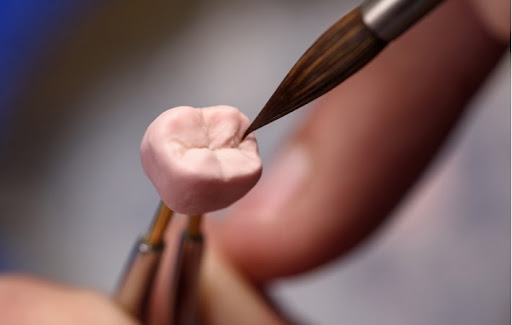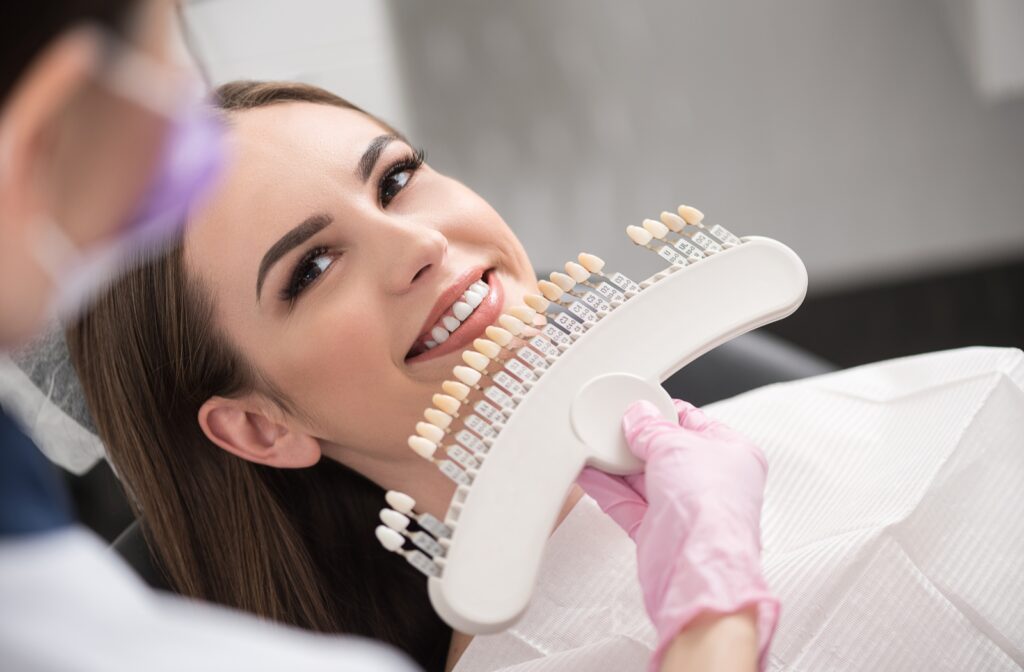During a dental exam and cleaning, your dentist may mention that you require a dental crown for a damaged tooth. For patients that haven’t previously had a dental crown, this might catch them by surprise.
Dental crowns are a form of cosmetic dentistry. They work to restore both the functioning and appearance of one’s tooth after it’s been damaged. To offer patients the optimal fit and appearance, different types of dental crowns may be used.
Keep reading to learn about the different types of dental crowns, why they’re used, and what dental crown is right for you and your teeth.
What Are Dental Crowns?
Dental crowns are covers that are placed on top of damaged teeth. In most cases, crowns are either used after a filling or if a filling can’t properly save the structure of a tooth. This is most common after a tooth has been damaged by tooth decay (cavities).
When a patient is suffering from tooth decay, the damaged part of the tooth must be removed to restore its proper functioning and appearance. At the start, a filling may be used, but over time a dentist may remove old fillings to replace them with dental crowns.
As each patient has a different medical history and different oral health, different types of dental crowns need to be used.
Different Types of Crowns
When your dentist first suggests a dental crown to you, they will recommend a type of crown and discuss a treatment plan for the crown. This plan could involve multiple visits to make sure your affected tooth is taken care of and the best results are achieved.
CEREC Crowns
CEREC (Chairside Economical Restoration of Esthetic Ceramics) crowns are also known as same-day crowns. The crowns are usually designed, created, and installed all using computer-assisted technology. Each crown is made custom for a patient’s tooth.
The advantage of CEREC crowns is the efficiency they provide dentists. If a patient needs a dental crown right away, CEREC crowns are perfect. Even though these crowns are designed and installed all in one day, their appearance still fits in well with the surrounding teeth.
Onlays
Onlays differ from regular crowns in how much of a tooth they cover. A traditional dental crown often covers the entire tooth, while an onlay won’t cover as much of the underlying tooth. The onlay focuses more on the biting surface of the tooth. Onlays are a more conservative approach to dental crowns.
Temporary Crowns
Temporary crowns are used to cover and protect a tooth while a dentist works on creating a customized permanent crown. As permanent crowns can take time to create, temporary crowns are an important part of protecting damaged teeth.
After a damaged tooth has been dealt with, the tooth and area around it can be sensitive and could be at risk of movement if the space isn’t maintained. If dentists are unable to use CEREC crowns, a temporary crown will likely be used in its place.

What Are Dental Crowns Made of?
Just as different types of dental crowns are used for specific reasons, different types of materials can be used to make crowns. These different materials are used for both function and appearance. Depending on the situation, the following are a few of the materials dental crowns might be made of.
Porcelain Crowns
Porcelain crowns are great for matching the colour of a patient’s teeth. The crowns have a natural colour that works well on the front and back teeth of patients. Porcelain crowns are one of the stronger crown options. However, porcelain crowns are sometimes prone to chipping or breaking. This likely happens as the crown begins to wear down.
Ceramic Crowns
Ceramic crowns are the best at matching the colour of the teeth around them. In addition to their appearance, these crowns are great options for patients with metal allergies. However, ceramic crowns are not one of the stronger crown options. Over time, they can potentially start to wear down the teeth opposite to them. Ceramic crowns are a good choice for front teeth.
Metal Crowns
Metal crowns are one of the stronger types of dental crowns. They rarely chip or break down and require less of the tooth to be removed. However, metal crowns are not great at matching the appearance of other teeth.
Metal crowns are typically made of the following:
- Gold
- Palladium
- Nickel
- Chromium
Metal crowns are a good choice for teeth that are out-of-site, likely at the back of the mouth.
All-Resin Crowns
All-resin crowns are typically the least expensive dental crown option for patients. The material is normally used for temporary crowns as they are prone to breaks and chips over time. However, the crowns are metal-free and can be made to match the colour of the patient’s teeth.
Cosmetic Dentistry
Dental crowns are a great solution for patients with damaged or decayed teeth. If you’re interested in learning more about our crowns or our other cosmetic dentistry options, book an appointment today!




